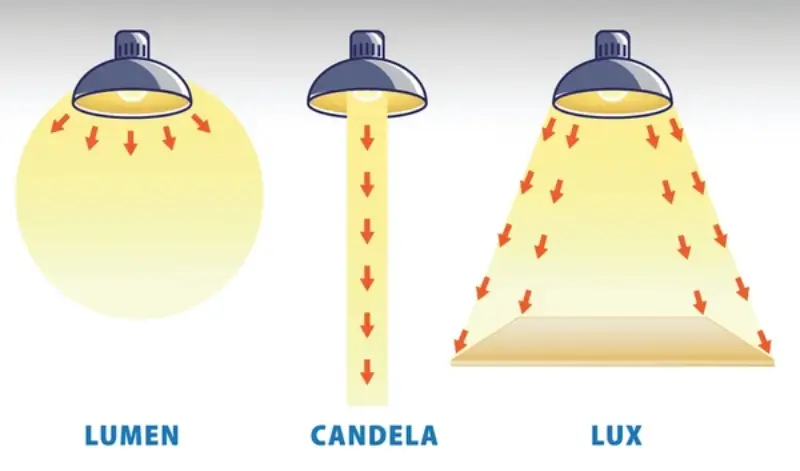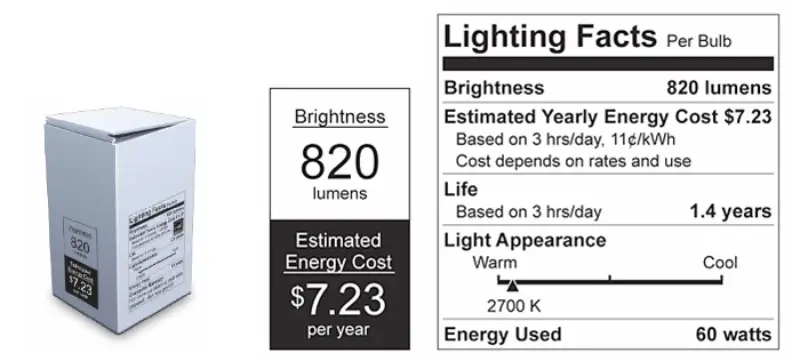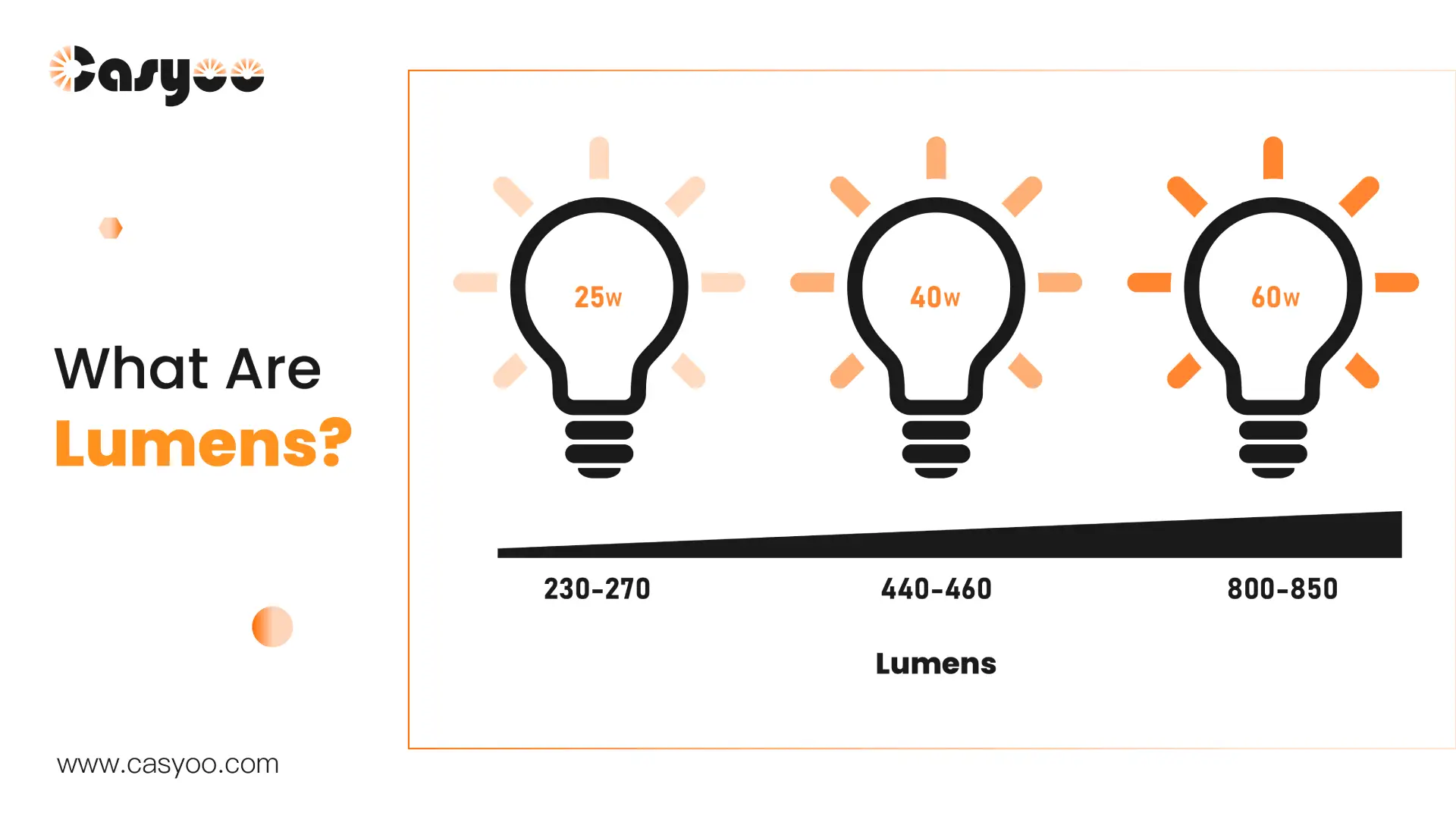Lumens are units of luminous flux that show how much light a light source emits per unit time. It measures the brightness seen by the human eye. Determining the brightness of a lamp by lumen is more accurate than merely by watt. In the passage below we will mention the specific reasons and give you a general and clear concept of the brightness of different lumen values, and how many lumens do you need for different space.
What are lumens?
As we mentioned above, lumens are used to measure the brightness of different light sources. People will perceive different lumens for different light sources with the same watt. There are mainly two reasons. The first explanation is that different colors of light are perceived differently by human eyes. If 1W of electrical energy is totally transformed into yellow-green light at 555nm, the human eye can detect a brightness of 683 lumens. For red, which the human eye is not sensitive to, 1W of light is only equivalent to 73 lumens. White light is special because the white light emitted by different light sources has different spectrum. White incandescent and LED lights have different spectrum, so even though their watt is the same, their lumens are different. The second reason, which has a greater influence on the lumen value, is the luminous efficiency, which we will mention in the next section.
Lumen, watt, and luminous efficiency
The relationship between lumen and watt is 1 lumen = 1 watt * 1 lumen/watt. Lumen/watt is the unit of luminous efficiency, which measures how much luminous flux can 1 W electricity be converted to. For an 1 W light source that emits 555 nm light, if it has 100% efficiency, people can perceive 683 lumens. But this is only an ideal case. In fact, there will be energy loss in the conversion process. In real life, maybe only 0.5 W of electricity can be converted into light, and the other 0.5 W will be transformed into heat. Then the luminous flux will be 341.5 lumens.
Incandescent lamps can basically only achieve an efficiency of 20 lm/W, because most of the electricity is converted into heat and invisible infrared light. But for LED lamps, their efficiency can reach 80-110 lm/W, and as LED technology matures, their efficiency keeps improving. Below is a comparison table of luminous efficiency, wattage and lumen of different types of lamps.
| Bulb type | Incandescent | Halogen | CFL | LED |
| 450 lm | 40 W | 29 W | 9 W | 6 W |
| 800 lm | 60 W | 42 W | 14 W | 9 W |
| 1100 lm | 75 W | 53 W | 18 W | 11 W |
| 1600 lm | 100 W | 72 W | 23 W | 14 W |
Lumen vs Candela vs Lux
Candela (cd) is a unit of luminous intensity used to quantify the brightness of light. It shows the amount of light emitted by a light source within a unit solid angle (unit steradian) and in a given direction. A light source has a luminous intensity of 1 candela when its luminous angle is 1 degree and its luminous flux is 1 lumen. So the difference between candela and lumen is that candela focuses on the intensity of light at a certain angle. For example, even if the luminous flux of a fluorescent lamp and an LED light is the same, the LED light source still looks brighter, because the fluorescent lamp radiates visible light in all directions, while the LED lamp generally has a designed luminous direction. Therefore, the luminous intensity of the LED light is greater, which makes the LED light appear brighter.
Lux is the unit of illumination, which indicates the luminous flux received by a unit area of an object’s surface. 1 lx = 1 lm/square meter. When a 100-lumen light source lights a one-square-meter area, the illumination is 100 lx. Using the concept of physics as an analogy, lumen is Force and lux is Pressure.

Lumens on lighting facts label
It used to be common to measure the brightness of the lamp through watt while choosing lamps, but this method is not suitable nowadays as more types of lights emerge on the market. With the rapid development of SSL (solid-state lighting) products, light output of different lamps with the same wattage may vary greatly. Therefore, the FTC (Federal Trade Commission) announced new lighting facts labeling rules, emphasizing the use of lumen values instead of wattage to measure the brightness of light bulbs. The front of the package should indicate the lumen output and the estimated annual energy consumption cost.

How bright is 1/100/1000 lumen?
1 lumen is roughly the brightness of a candle within one meter. 10 W incandescent lamp can emit 100 lumen light. 1000 lumens is the brightness of a car’s low beam. If you have any lamp mentioned in the table above and know its wattage, you can refer to the table and recall how bright different lumen values look like. In addition, we will introduce the lumens of the lighting for different applications for your reference in the next section.
How many lumens do you need for your space?
When mentioning the lighting standards, we usually use lux level instead of lumen values. This is because areas with different sizes will need different lumens, and lux level measures the lumen value per square meter, unifying the standards. For example, while there are large parking lots for 400 cars, some parking lots are smaller and only designed for 100 cars. To meet the same lux level requirement, large parking lots will need more lumens than the small ones.
To calculate the lumens you need, you can multiply the lux level by the size of your space (Lumen=Lux level*size). This is only a rough measurement because besides lux level, there are other factors such as the light loss factor and the utilization factor that influence the specific lumen values you need. Therefore, you need to talk to the manufacturers for precise planning. The following are some standards for different space. You can also use our lumen&watt calculator to help you decide the specific type of light you need!
Indoor lighting
| Room | Area (m2) | Lux level (lx) | Lumen (lm) |
| Bedroom | 10 | 150 | 1500 |
| 12 | 1800 | ||
| 15 | 2250 | ||
| Living room | 20 | 200 | 4000 |
| 25 | 5000 | ||
| 30 | 6000 | ||
| Dining room | 7 | 150 | 1050 |
| Kitchen | 8 | 250 | 2000 |
| Bathroom | 4 | 150 | 600 |
| Balcony | 6 | 150 | 900 |
Outdoor lighting
| Type of lights | Lux level (lx) |
| Street lights | 20-30 |
| Parking lot lights | 20-50 |
| Decorative street lights | 15-20 |
| Lawn lights | 10-20 |
| Underground lights | 10-15 |
| Garden spotlights | 10-20 |
| Garden floodlights | 15-20 |
Commercial lighting
| Area | Lux level (lx) |
| Offices | 400-500 |
| Warehouses | 100-300 |
| Retail stores | 400-500 |
| Grocery | 500 |
Conclusion
After reading this passage, you must have known that while choosing lights, you should look for lumens instead of watt. Different types of lights have different efficiency, and you can check the chart we offered to know the relation between lumens, watt, and light sources more clearly. If you want to buy light bulbs, the lighting facts label on the package will be helpful. Moreover, you can refer to the standards we provided to roughly measure how many lumens you need for different space. Contact us and let our experts recommand the right LED lights with the right lumens!




